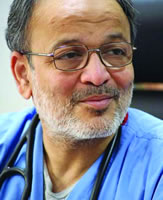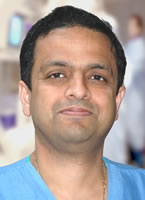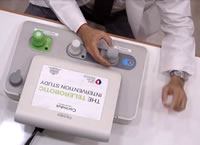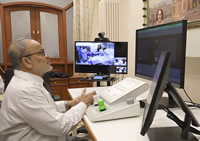|
Q: Describe the technical and clinical setup, both in the cath lab at Apex Heart Institute, where the patients were, and at the Swaminarayan Akshardham Temple in Gujarat, India, 32 km (20 mi) away, where you were located, performing the first telerobotic coronary intervention.
There are three different buttons: one to maneuver the guidewire forward, backward, as well as clockwise and counter-clockwise; one to maneuver the guide catheter, again, forward, backward, clockwise and counter-clockwise; and one to maneuver the balloon catheter or stent catheter, that will bring it forward and backward. And there is one more: a “turbo” button when we want to quickly go in and out with either guidewire or balloon or stent catheter. So this is the basic requirement for any robotic procedure. It’s been done in the U.S. since the last few years. We started on December 5, 2017, and within one year we had done 300 cases. Dr. Samir Pancholy has been part of the whole thing and we set this program rolling at my place, the Apex Heart Institute. The new thing with distance telerobotic stenting is the wireless router. Animal studies were done at Mayo Clinic, Rochester. I spent two days there. We learned all the intricacies and then after doing complete procedures, we were ready to do the case in India. After finishing all the formalities through our ethics committee process, we set everything right.
Q: Why did you select this particular location? The minimum requirement of the bandwidth was between 50 and 100mbps. We made sure that it remained 100mbps and everything was set at one of the conference rooms in the Akshardam. The ingenious team and the scientist team from Corindus helped up set everything right and we tested the frequency and everything; it was working perfectly. Samir arrived a couple of days earlier. So we did five cases on December 5 and fortunately all were typical lesions and we were able to fix them in less than ten minutes time for practically every case. Q: So you didn’t just do one case; you did five? Q: That first case is available to watch on YouTube, right? Q: What types of lesions are these: which arteries? are they complex, simple? Q: What type of approach did you use: radial or femoral? Q: To recap, many have seen robotic PCI where the operator sits behind a screen in the cath lab. So technically this is the same equipment except instead of the operator being in the room, you’re being connected with a 100 mbps network? Q: Ok. I’m going to play devil’s advocate now. So, if you have a well-equipped cath lab with all the equipment in it, and the technicians and nursing staff, what is the advantage of having the interventional cardiologist 20 miles away? For example, in a country like India or many Asian countries where, you know because of the infrastructure issues, there are cath labs available in underprivileged area, but senior cardiologists don’t want to settle there. And there are young guys who are working there; they’re doing regular cases, but we want to shift the high-risk cases, some very bad acute M.I.s, to the higher centers. I think this technology can be of great help if you have some good trained staff over there and they fix the patient on robo, a senior or an experienced guy sitting away, maybe a hundred miles or a thousand or ten thousand miles, can fix the block. And in a country like US, if you can’t airlift the patient, it can be of great use. And the major implications will not be confined only to coronary, but acute stroke management, and they’re working on that. It’s going to be a great help where the time is muscle. You have to make sure that you can do thrombolysis and the retrieval of the thrombus from the arteries of the brain in first six hours. This can be a great help. Samir, can you add something? Dr. Pancholy: Sure. I You know, Burt, this expands the reach of expert PCI beyond the boundaries of distance. For example in the U.S. right now we transfer people and we barely make those balloon times. If this type of setup was easily available, then you could have a basic level of staff and a cath lab in the middle of nowhere, so to say, and a very expert team from a center like New York or Philadelphia could actually go ahead and do a PCI sitting miles away. And you know, I think STEMI probably would be the lowest-hanging fruit because those PCIs are usually not very complicated lesions, they’re soft lesions, they’re usually proximal and you can get to them quickly, but they’re very time-sensitive. And then, like Tejas said, stroke is another big deal where time is of major importance and I think in all these areas where we have a contracting pool of experts and an expanding pool of patients, you can basically mitigate some of the disadvantages by employing such a technology.
And actually it was very amazing to see how good the system responded over a 100mbps or even maybe a little bit less type of a connection. The maneuvering of the equipment from a distance was unbelievably awesome. There was no real delay between the responses on either side and the patient actually felt very comfortable. We interviewed the patient and there was a pre-defined questionnaire that we gave to the patient after every case and the response was very reassuring. They were not unnerved, they felt very much normal. You could see it on the screen. Dr. Patel: And going one step ahead, imagine the role of artificial intelligence if you have a system by which you have the complete report of CT coronary angiogram and CT of the arm, subclavian, and femoral, abdominal and ascending aorta and everything available. And if you feed those data, you know, to the robo, and then the robo is ready with everything. And your puncture, guidewire, guide catheter, balloon, everything will track as for the artificial intelligence. The ultimate aim is to reduce the difference in the results between an extremely experienced cardiologist and a non-experienced cardiologist. If I do acute MI and Samir does acute MI, the complication rate will definitely be low because we have done it for ages. But the new guy may end up with complications. So all those differences between an experienced cardiologist and a non-experienced cardiologist are going to shrink. Dr. Pancholy: Solving the problem of shortage of expertise and the distances was one of the issues and I think the robot is an essential piece of remote wireless type of therapeutic intervention, which is a major upcoming movement of telemedicine. But I think the other thing that Tejas just pointed out is the patient safety aspect of robotics. Because, for example, in the general surgical and urology world, robotic prostatectomy is significantly better in outcomes compared to a routine open prostatectomy done by a very experienced surgeon. For a very simple reason: that the nerves and everything that’s right around the prostate is very carefully avoided by a robot which has super-precise movements. So the same thing sort of, with incorporation of haptics and some artificial intelligence type preset data, we just can go and work within the boundaries of, I think this will improve patient safety. At Apex Heart Institute that’s one of our goals: to research the robotic space in the coronary world not from an angle of what has been done so far, which is that the operator can sit at a distance and work, but we actually want to see how can the patient benefit from it. How can we make the procedure safer, more precise, also in some aspects more “idiot-proof” so they say, so that, you know, if an inexperienced operator is about to make a mistake, the robot will stop that process and not let him or her do that sort of thing. Dr. Patel: Let’s take the example of transradial. You know when transradial started, Burt, people criticized that it’s a cosmetic procedure, and there’s nothing wrong with femoral, this and that. But it took time to dig out the benefit of transradial in the highest risk populations of coronary and now people realize. So we are going to work hard to make sure to show what are the benefits to the patient. Because benefit to the cardiologist does not solve the complete purpose. Q: I love the image though, of an interventional cardiologist walking around with a briefcase to do procedures. And in India, going from temple to temple. Quite a vision. What are the next steps in this study that you’re going to be doing, if that’s something you can talk about? Q: Is there a tactile feel when you’re working with the dials or the procedure, do you get a sense of resistance and things like that? Dr. Pancholy: Yeah, Burt. It’s one of the interesting things that I observed and kind of learned and kind of makes sense retrospectively, that what we as interventional operatives refer to as a “tactile feel” and which is a part of our skill development, actually surprisingly, the majority of that domain is contributed by the visual feel; the visual feel, not the actual tactile feel. And you only realize when you’re sitting twenty miles away and you can still get an idea of how to turn the wire to cross the lesion, because you know there is absolutely no physically possible tactile feel there, right? Because you are far away from it. But even then you can precisely move the wire into a vessel, which is 2, 3 millimeters in diameter. So when I look back, if I am observing somebody’s procedure and I’m not the operator, I can still kind of adjust and tell them what to do if they ask me, even though I’m not feeling the wire, because most operating is visual. So I think we are also learning a lot about how one learns to do this. And it’s a very interesting and very complex kind of mix of input and feedback that we incorporate into our professional experience and then we use it. It’s a big learning process. I think it’s going to explode from that angle also that we’ll realize how to teach people properly. My big expectations from the robot is enhanced procedural safety with some boundaries set for making sure that we don’t cause any damage, that we will have certain kind of checks and balances so that you cannot push the equipment unreasonably hard and make the vessel perforate, or a variety of things could be put in place so that there’s increased safety. Q: And can the software do that? Q: Yes, I saw on the YouTube video the manipulation of the wire going into the right artery was so fast you could hardly see it, but it was amazing that it was 20 miles away and bing bang boom there you are, you’re down the right artery and right across the lesion. Q: Do you see being able to do much more complex procedures, like you were saying CTOs, other types of procedures, imaging procedures, like with IVUS and things like that? Q: Great. Thank you both for your time! [Editor's Note: On September 3, 2019, Drs. Patel, Pancholy, and Shah's report, "Long Distance Tele-Robotic-Assisted Percutaneous Coronary Intervention: A Report of First-in-Human Experience," was published in EClinicalMedicine/Lancet.] This interview was conducted in January 2019 by Burt Cohen of Angioplasty.Org. |






